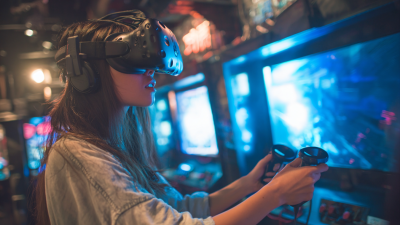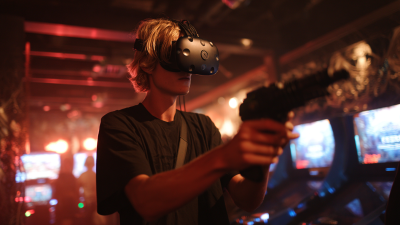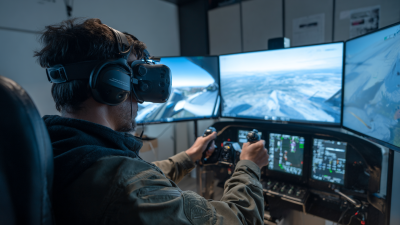Digital Revolution: Discover the Best Commercial VR Simulator 9D Experience for Your Business
Table of Contents
- Exploring the Rise of 9D VR Simulators in Commercial Settings
- Understanding the Impact of Immersive Experiences on Customer Engagement
- Key Market Trends Driving the Adoption of VR Technology in Business
- Analyzing ROI: How 9D VR Simulators Enhance Revenue for Companies
- Comparison of Leading 9D VR Simulator Brands in the Industry
- Future Predictions: The Evolution of VR Technology in Commercial Use
- FAQS
- Conclusion
- Related Posts
As businesses increasingly seek innovative ways to engage customers and enhance experiences, the demand for immersive technologies has skyrocketed. The global market for virtual reality (VR) is projected to reach USD 57.55 billion by 2027, driven by advancements in technology and a growing preference for interactive entertainment. In this dynamic landscape, "Commercial VR Simulator 9D" experiences are at the forefront, offering unparalleled levels of immersion through advanced motion simulation and 3D visuals.

With over a decade of expertise, Guangzhou Longcheng Electronic Co., Ltd., a pioneer in the VR simulator manufacturing sector in China, stands out as a leader in this field. Our company boasts an extensive 8000 square meter facility and a dedicated team of over 60 staff, ready to provide one-stop solutions for VR projects that cater to diverse commercial needs.
Embracing the digital revolution, businesses partnering with us can harness the full potential of VR technology to create unforgettable customer interactions and drive growth.
Exploring the Rise of 9D VR Simulators in Commercial Settings
The rise of 9D virtual reality (VR) simulators in commercial settings is reshaping the landscape of entertainment, education, and training across various industries. Recent industry reports indicate that the global VR market is expected to reach $57.55 billion by 2027, with a significant portion attributed to immersive experiences provided by 9D simulators. These advanced systems combine motion, visuals, and sensory feedback to create an unparalleled user experience, making them ideal for attractions such as arcades, amusement parks, and even corporate training environments.
The effectiveness of 9D VR simulators in engaging users is underscored by a survey from Statista, which highlighted that 74% of respondents found VR experiences to be deeply immersive compared to traditional media. This immersive quality not only enhances customer satisfaction but also increases dwell time in commercial venues, directly correlating with higher revenue potential. As businesses look to differentiate themselves in a competitive market, investing in 9D VR technology is emerging as a strategic move to attract and retain customers while delivering innovative experiences that could lead to substantial growth.

Understanding the Impact of Immersive Experiences on Customer Engagement
The impact of immersive experiences on customer engagement is profound, especially in the context of
9D virtual reality (VR) simulators. According to a report by PwC, 51% of consumers prefer experiences over products, highlighting a shift towards engaging, interactive activities that VR provides.
Businesses leveraging 9D VR technology can significantly enhance customer engagement by creating memorable experiences that captivate audiences and foster stronger emotional connections. This is particularly relevant in retail, where immersive experiences can lead to increased foot traffic and longer dwell times.
Additionally, Gartner reported that by 2025, 75% of consumers will engage with brands through augmented reality (AR) and virtual reality content. This growing trend indicates that businesses investing in advanced VR simulators are better positioned to meet changing consumer preferences.
By immersing customers in realistic environments and scenarios, brands can elevate their marketing efforts, drive brand loyalty, and ultimately increase sales.
As businesses continue to explore the potential of VR technology, the importance of fostering engaging customer experiences will only become more critical in a competitive marketplace.
Key Market Trends Driving the Adoption of VR Technology in Business
The German virtual reality (VR) market is experiencing significant growth, fueled by key trends that are driving the adoption of VR technology in various business sectors. As businesses increasingly recognize the potential of VR to enhance customer engagement and improve training processes, the market is expected to expand considerably. In 2023, the market size for gaming VR exceeded $4.59 billion, with a projected compound annual growth rate (CAGR) of around 30% from 2024 to 2032. This growth is largely attributed to ongoing advancements in technology and hardware that enhance the immersive experience for users.
Additionally, the VR simulator segment, including devices like head-mounted displays and haptic gloves, is gaining traction as more companies integrate VR solutions for different applications. The demand for immersive environments in retail, healthcare, and education is driving investments in VR components such as hardware, software, and content development. As the demand for personalized and engaging experiences continues to rise, businesses are likely to adopt these solutions to stay competitive and meet evolving customer expectations. The impact of these trends underscores the transformative potential of VR technology in reshaping business operations and customer interactions.
Digital Revolution: Discover the Best Commercial VR Simulator 9D Experience for Your Business - Key Market Trends Driving the Adoption of VR Technology in Business
| Feature | Description | Market Trend | Potential Growth (%) |
|---|---|---|---|
| Immersive Experience | Provides a fully immersive digital environment, engaging the user. | Increasing demand for experiential marketing. | 30% |
| Health & Fitness | VR used in physical training and rehabilitation. | Growth in health and wellness industries. | 25% |
| Corporate Training | Simulations for skill development and safety training. | Shift towards virtual learning environments. | 35% |
| Entertainment | Interactive games and experiences in theme parks. | Rise in popularity of VR entertainment. | 40% |
| Real Estate Visualization | Virtual tours of properties before they are built. | Demand for remote viewing options. | 20% |
Analyzing ROI: How 9D VR Simulators Enhance Revenue for Companies
The integration of 9D VR simulators into business environments presents lucrative opportunities for revenue enhancement. According to a recent report by MarketsandMarkets, the global virtual reality market is projected to reach $57.55 billion by 2027, growing at a CAGR of 44.7% from 2020. This staggering growth underscores the increasing demand for immersive experiences across various sectors, including entertainment, education, and tourism. Businesses that invest in state-of-the-art 9D VR simulator technology can not only attract more customers but also improve overall engagement, leading to an increase in repeat business.
Furthermore, a study conducted by Statista reveals that 62% of consumers are willing to pay more for experiences that offer immersive virtual reality features. By implementing 9D VR simulations, companies can create memorable customer experiences that drive higher spending and extend customer dwell time. This enhanced customer interaction often translates into a significant uptick in sales, demonstrating how the cutting-edge technology can directly impact a company's bottom line. With the ability to offer unique and innovative experiences, businesses can position themselves at the forefront of the digital revolution, capitalizing on both immediate and sustained revenue growth opportunities.
Comparison of Leading 9D VR Simulator Brands in the Industry
In the rapidly evolving landscape of virtual reality, businesses are increasingly turning to 9D VR simulators to enhance customer engagement and provide immersive experiences. The market is teeming with various brands, each offering unique features and technologies that cater to diverse business needs. A thorough comparison of the leading 9D VR simulator brands reveals key factors that businesses should consider, such as the quality of simulations, user interface, content variety, and overall user experience.
Among the paramount considerations is the type of content available for the simulators. Brands that offer a rich library of immersive experiences and regular updates tend to stand out in the industry. Businesses must also evaluate the reliability and support services provided by these brands, as operational downtime can significantly impact customer satisfaction. Additionally, the cost of investment versus the potential return in engaging a broader audience is crucial in making an informed decision. By carefully comparing the strengths of each brand, businesses can select the best 9D VR simulator that aligns with their objectives and consumer expectations.
Comparison of 9D VR Simulator Features
Future Predictions: The Evolution of VR Technology in Commercial Use
The landscape of virtual reality (VR) technology is experiencing rapid evolution, particularly in commercial applications. With the global gaming console market projected to reach $51.5 billion by 2027, a compound annual growth rate of 5.3% illustrates a robust demand for immersive experiences. As businesses increasingly adopt VR to enhance customer engagement, the focus is shifting towards high-quality simulation experiences that captivate audiences. The rise of 9D simulators offers unparalleled sensory experiences, setting a new standard for entertainment and training applications across various industries.
Looking ahead, the themes and styles in VR entertainment are expected to diversify significantly. As audience preferences evolve, the incorporation of personalized content and innovative storytelling techniques will become essential. The growing integration of advancements in graphics and interaction modalities will not only enhance user experiences but also create new opportunities for diverse storytelling. This expansive vision for VR technology highlights its role as a transformative force in entertainment and commercial sectors, and companies that leverage these advancements early on will likely gain a competitive edge in the market.

FAQS
: 9D VR simulators are advanced systems that combine motion, visuals, and sensory feedback to create immersive experiences. They are used in various commercial settings such as arcades, amusement parks, and corporate training environments.
The global VR market is projected to reach $57.55 billion by 2027, largely driven by immersive experiences provided by technologies like 9D simulators.
9D VR simulators enhance customer satisfaction by providing deep immersive experiences, which can increase dwell time in commercial venues and directly correlate with higher revenue potential.
The growing recognition of VR's potential to enhance customer engagement and improve training processes, alongside advancements in technology and hardware, are key trends driving the adoption of VR in various business sectors.
The gaming VR market exceeded $4.59 billion in 2023 and is projected to grow at a compound annual growth rate (CAGR) of around 30% from 2024 to 2032.
There is increasing demand for immersive environments in sectors such as retail, healthcare, and education, driving investments in VR hardware, software, and content development.
Future VR entertainment is expected to diversify significantly, focusing on personalized content and innovative storytelling techniques, enhanced by advancements in graphics and interaction modalities.
Companies that leverage advancements in VR technology early will likely gain a competitive edge in the market as they enhance customer engagement through high-quality simulation experiences.
Conclusion
The article "Digital Revolution: Discover the Best Commercial VR Simulator 9D Experience for Your Business" delves into the growing adoption of 9D VR simulators in commercial environments. It explores how these immersive experiences significantly enhance customer engagement, driving market trends that boost the use of VR technology in various industries. The discussion includes an analysis of the return on investment (ROI) that companies can achieve through the implementation of commercial VR simulator 9D experiences, as well as a comparison of leading brands within the industry.
Furthermore, the piece considers future predictions for the evolution of VR technology in commercial use, highlighting the potential for businesses to leverage innovative solutions to stay competitive. Companies like Guangzhou Longcheng Electronic Co., Ltd. VART VR, a pioneer in the field with extensive experience and a comprehensive project offering, exemplify the opportunities presented by the commercial VR simulator 9D market.
Related Posts
-

Exploring the Best Hong Kong VR Arcade Options: A Comparative Guide for Global Buyers
-

What Makes VR Arcades a Revolutionary Experience in Entertainment
-

The Definitive Guide to Understanding Vr Machine Price and Its Market Trends
-

7 Ultimate Tips for Choosing the Best Gaming Chair for VR Experience
-

From China's Leading Factory The Trusted Source for the Best VR Race Game Globally
-

Addressing Common Issues in VR Airplane Simulators: Solutions for Improved Experiences

